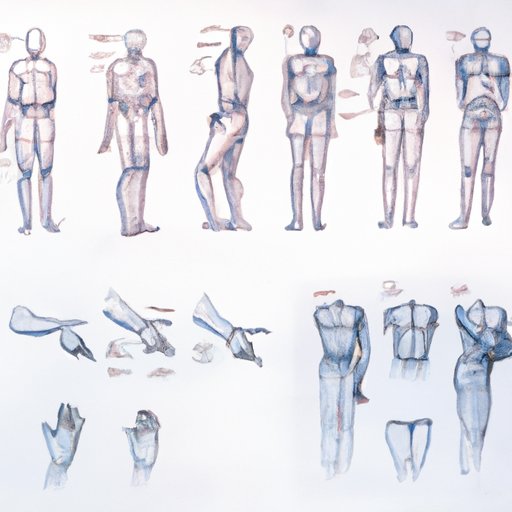Introduction
If you are someone who loves drawing and wants to learn how to draw the human body, then you’re in the right place. Drawing the human body can be challenging but with the right guidance and techniques, anyone can learn. In this step-by-step guide, we will explore different techniques and methods to help you learn how to draw human figures and enhance your skills as an artist.
Step by Step Guide on How to Draw a Human Body
When it comes to drawing the human body, it is essential to start with the basics. The first step is to focus on geometric shapes such as circles, ovals, and triangles to create the figure’s basic structure. From there, you can add details such as limbs, facial features, and clothing as you progress in the drawing process.
In the next stage, you should start refining the basic shapes into a more detailed and realistic structure. Pay attention to the curves and angles of the human body, particularly the torso, arms and legs. With each step, you can add more details to solidify the figure’s form and movement.
Finally, when satisfied with your drawing, you can add textures and shades to your figure to provide depth and dimension to it.

Different Techniques for Sketching Human Anatomy
There are various techniques artists can use to sketch the human body, each with its unique approach and decided goal.
One of these techniques is contour drawing, which is drawing an object’s outline in one continuous line. The artist must focus on the figure’s shape, movement and the outlines of shadows to create a complete and realistic chart of the body.
Another method is gesture drawing, which entails the artist making rapid sketches that capture the movement and pose of a person. Gesture drawings allow the artist to represent the figure’s movements through quick and loose sketches, often less than a minute.
Cross-hatching is another technique that allows artists to add texture, depth and shadow to their work. By using a series of lines that overlap, the artist can give the drawing a sense of depth and three-dimensional feel.
The Importance of Proportions and How to Achieve Them in Figure Drawing
To draw a realistic human figure, it is essential to pay attention to the body’s proportions. Correct proportions help the artist to attain an accurate representation of the subject. To achieve excellent outlines, the artist must focus on the head count, alignment, and joint construction method.
Head count, based on the body’s proportions, uses the size of the person’s head as a unit of measurement to determine the length of different body parts accurately. By using this technique, the artist can have a realistic and idealistic drawing of the body’s proportions that are different in people.
Similarly, alignment works by dividing the body into individual sections allowing the artist to arrange each section with the others accurately.
Lastly, joint construction allows the artist to use the joints and points of the body to create a realistic outline. By using this method, the artist can achieve correct proportions and movement, making the figure look more realistic.
Using Reference Materials to Enhance Your Understanding of Human Structure
Learning anatomy and getting a better grasp of the human structure is essential for anyone who wants to draw the human body realistically. One way to achieve this is by getting credible resources, such as anatomy books, videos, and art galleries.
Books can help artists learn about the different parts of the body, how they connect and move, and how their shapes vary depending on different people. Art galleries and museums can provide a hands-on view of the human body for artists to observe and study and get inspiration from.
Tips for Practicing and Improving Body Drawing Skills
Like learning any new skill, regular practice is critical when drawing the human body. It is essential to take the time to practice, explore, and experiment with different approaches and styles.
One exercise that can help is sketching live models or people in everyday life. Sketching from live models allows the artist to observe their movements and how their bodies change pose and structure in different positions. Sketching people in everyday life allows the artist to use real-life references to create their work. Additionally, artists can experiment with different media to create texture and add personality in their work.
Common Mistakes to Avoid When Drawing the Human Body
When drawing the human body, several common mistakes artists tend to make. One of these mistakes is to make body parts too large or too small, causing an inaccurate representation of the figure’s proportions.
Another common mistake is inaccurate placement of body parts. For example, a misplaced shoulder joint can make the figure’s arms appear to be in the wrong position.
Artists must avoid such mistakes, continually refine their techniques, and observe the human body to enhance their work and avoid inaccuracies or errors.
Conclusion
Drawing the human body takes practice, patience and a willingness to learn. This step-by-step guide, highlighting techniques such as contour drawing, accurate proportions and gesture drawing, provides insight into how one can improve body drawing skills.
Using credible resources, learning anatomy, sketching from life and experimenting with different mediums can help artists enhance their skills and avoid common mistakes. We hope you found this guide helpful and encourage you to incorporate these tips and techniques in your art practice.
